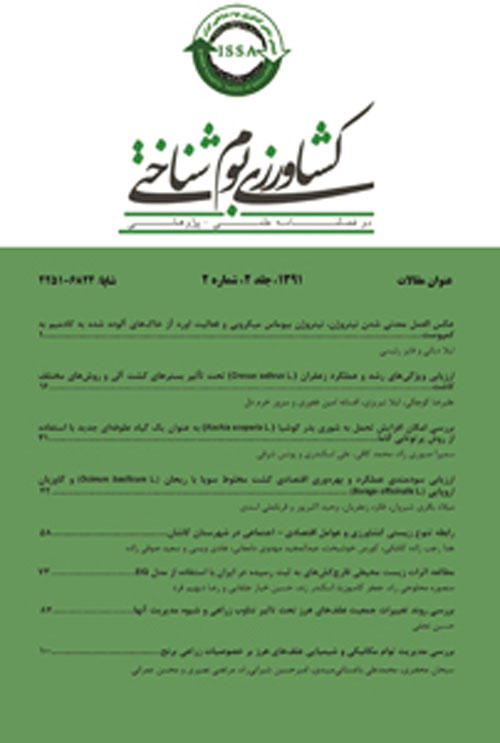The Impact of different densities of fenugreek (Trigonella foenum-graecum L.) as a cover crop on competition between weed and sunflower
Author(s):
Article Type:
Research/Original Article (دارای رتبه معتبر)
Abstract:
Introduction
Agronomic approaches to weed management are effective, low-cost, environmentally-friendly options without adverse effects on human health. These approaches should be emphasized to develop a sustainable agriculture (Zimdahl, 2007). A living cover crop can affect weed competition by competing for growth resources and the residue of cover crops may affect weed growth and competition with their allopathic potential (Karbalaei-Khiavi et al., 2016). Fenugreek plants, with their shallow root system, ability of nitrogen-fixing as well as allopathic potential, were chosen as a cover crop to study the effects of various densities of fenugreek on growth and weed competition.Materials And Methods
An experiment was conducted in a randomized complete block design with six treatments and three replications at the experimental station of Torbat-e Jam University in 2016. The treatments included the seeding of 0, 10, 20, 30 and 40 fenugreek plants per square meter as a cover crop and a control treatment. The destructive sampling was taken to determine the dry matter production in sunflower, fenugreek and weed from 60 cm of rows. After examining the residuals for normality, analysis of variance was done using SAS software.Results And Discussion
The highest and lowest weed dry matter were obtained from the densities of 0 and 20 fenugreek plants per square meter, respectively. The results showed that the planting of fenugreek, regardless of its density, at the same time as the sunflower planting reduced growth of competing weeds by at least 50%. This reduction can also be increased by up to 78% by establishing the appropriate density of fenugreek. The highest and lowest leaf area, dry matter production and seed yield in the sunflowers was obtained from densities of 20 and 40 cover crop plants per m-2, respectively. The presence of cover crops in all densities, except for 20 fenugreek plants per m-2, significantly reduced sunflower yield compared with the control. Regression analysis also showed that the response of sunflower growth and yield to increased cover crop density follows a quadratic trend. The sunflower growth and yield was reduced at lower and higher densities of cover crop compared to its optimum density. The role of cover crop densities higher than the optimum level, however, was greater than the lower one in reducing competing weeds. Thus, the establishment of a suitable plant density of fenugreek would occupy an existing vacant niche, reduce available growth resources, and ultimately reduce the growth of competing weeds (Mohammadi et al., 2015).Conclusion
Due to the reduction of competing weeds in the presence of fenugreek and the economic value of fenugreek production, this plant can be used as an effective cover crop in sunflower fields as an option in a comprehensive weed management system. Keywords:
Language:
Persian
Published:
Journal of Agroecology, Volume:8 Issue: 1, 2018
Page:
31
magiran.com/p1846586
دانلود و مطالعه متن این مقاله با یکی از روشهای زیر امکان پذیر است:
اشتراک شخصی
با عضویت و پرداخت آنلاین حق اشتراک یکساله به مبلغ 1,390,000ريال میتوانید 70 عنوان مطلب دانلود کنید!
اشتراک سازمانی
به کتابخانه دانشگاه یا محل کار خود پیشنهاد کنید تا اشتراک سازمانی این پایگاه را برای دسترسی نامحدود همه کاربران به متن مطالب تهیه نمایند!
توجه!
- حق عضویت دریافتی صرف حمایت از نشریات عضو و نگهداری، تکمیل و توسعه مگیران میشود.
- پرداخت حق اشتراک و دانلود مقالات اجازه بازنشر آن در سایر رسانههای چاپی و دیجیتال را به کاربر نمیدهد.
In order to view content subscription is required
Personal subscription
Subscribe magiran.com for 70 € euros via PayPal and download 70 articles during a year.
Organization subscription
Please contact us to subscribe your university or library for unlimited access!


